Toxic work culture and high employee turnover are serious problems in the tech world.
No one wants to work in an unhealthy environment. At the same time, no employer wants to lose great talent because of poor company culture.
The solution? A strong and supportive workplace culture that works for both employees and businesses.
But in fast-moving industries like tech, building that culture isn’t always easy.
In this guide, we explore how 10 leading tech companies have successfully created work environments that support their teams, improve retention, and boost overall employee happiness.
Table of contents
TL;DR
| Tech Company | Industry/Services | Employee Work Culture Highlights |
| Netflix | Video Streaming | Dedication to storytelling, freedom, accountability, and excellence |
| Professional Networking | Inclusivity, truth-seeking, and member-focused culture | |
| Search Engine & Tech Services | Flexible work culture, inclusivity, and extensive employee benefits | |
| Amazon | E-commerce & Tech Services | Above-average compensation, diversity, safety, and work-life balance |
| Semrush | Online Visibility Management | Trust PTO policy, equal opportunity, and diversity initiatives |
| Airbnb | Online Accommodation Marketplace | Remote work flexibility, global talent, and trust-driven culture |
| Microsoft | Software & Tech Services | Growth mindset, employee well-being, and comprehensive benefits |
| Adobe | Software & Creativity Products | Employee recognition, work-life balance, and family-friendly policies |
| Zoom | Video Conferencing Software | Care-focused culture, “Zoom Happiness Measure,” and flexibility |
| Oracle | Cloud Services & Software | Diversity and inclusion, resource groups, and talent development |
What is a good work culture?
A good work culture at a company is one where employees feel valued, respected, and motivated. It promotes open communication, collaboration, and work-life balance while fostering a sense of purpose and belonging.
Elements of a good and health work culture at an organization:
- Employees feel valued, respected and supported
- There is open communication and transparency
- Employees are empowered and trusted to do their work
- There are opportunities for growth and development
- Teamwork and collaboration are encouraged
- Diversity and inclusion are promoted
- Employees’ well-being is prioritized
1. Netflix’s culture of excellence, freedom, and responsibility
Netflix Inc. is a popular global subscription-based video-on-demand OTT streaming service company, and there’s hardly anyone who hasn’t heard its name.
Netflix’s employee work culture:
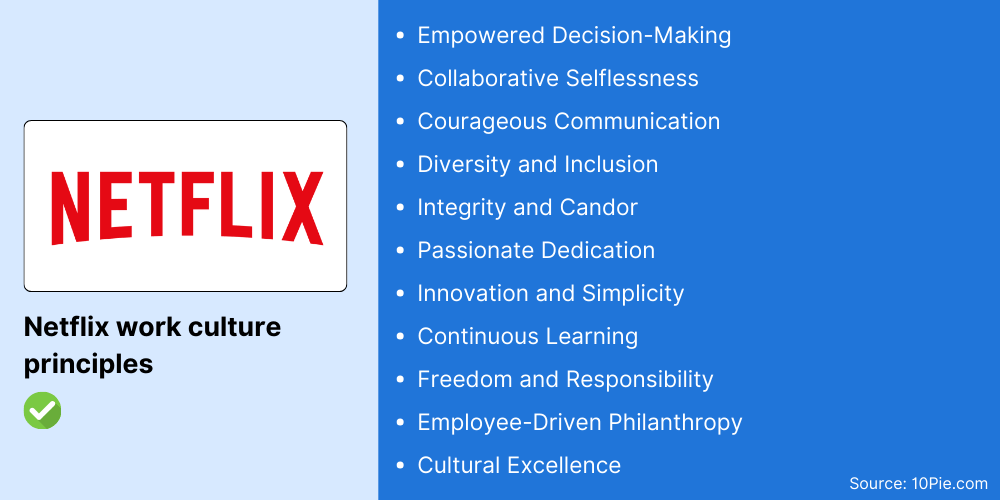
Netflix prides itself on its unique employee culture, driven by a dedication to storytelling and a people-first approach. The company values employee engagement through encouraging decision-making, open communication, and sharing information extensively.
They prioritize hiring highly effective individuals and maintaining a flexible, collaborative work environment that promotes creativity and innovation. Their culture revolves around defined behaviors such as judgment, selflessness, courage, communication, inclusion, integrity, passion, innovation, and curiosity.
The company embodies a “dream team” ethos, valuing effectiveness over effort and striving for excellence. Employees are trusted with significant freedom and responsibility, reflecting a culture of trust and accountability.
Apart from all this, the company’s commitment to continuously evolving and enhancing its culture is also a reason behind its employee satisfaction.
2. LinkedIn’s work culture and values
LinkedIn is a popular social networking site specially designed for business communities. The goal of this company is to build the world’s largest professional network and support users in boosting their professional careers.
LinkedIn’s employee work culture:
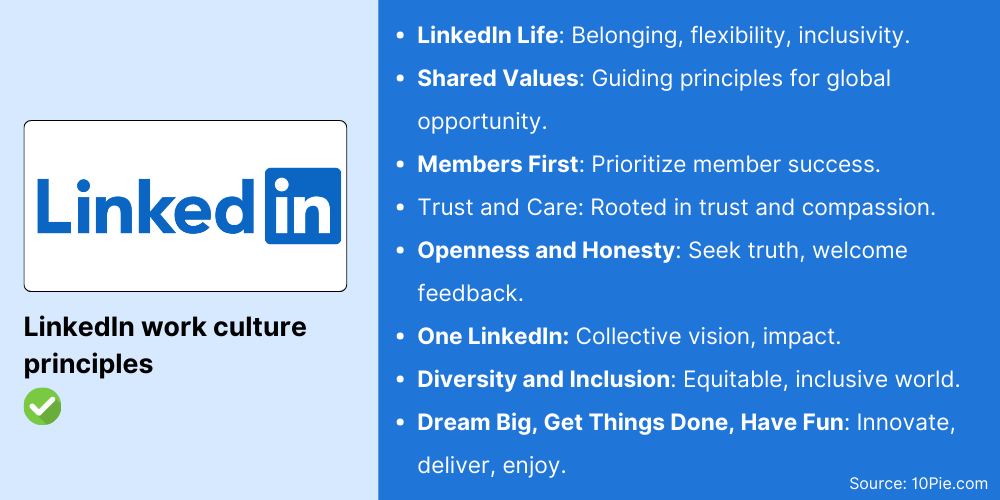
LinkedIn’s work culture is all about inclusivity, flexibility, and aiming big. Similar to Netflix, they also follow a people-first approach, where they always prioritize doing what is right for the members to make them more productive and successful.
The company’s culture highly values seeking truth and keeping it real through constructive feedback so the employees can learn and grow better. To eliminate the tussle of working with a global team, they train each of their employees to take responsibility and make decisions in alignment with the company’s goal, which is “doing goos along with doing well.”
LinkedIn embodies diversity and inclusion and actively tries to create an environment where different perspectives and experiences from different people are sought and valued.
3. Google’s commitment to employee diversity
Google is a company that needs no introduction, but for those who don’t know, it is the largest online search firm that now has over 50 internet services and products, like search engine, cloud storage, and browser to wearables and smart devices.
Google’s employee work culture:
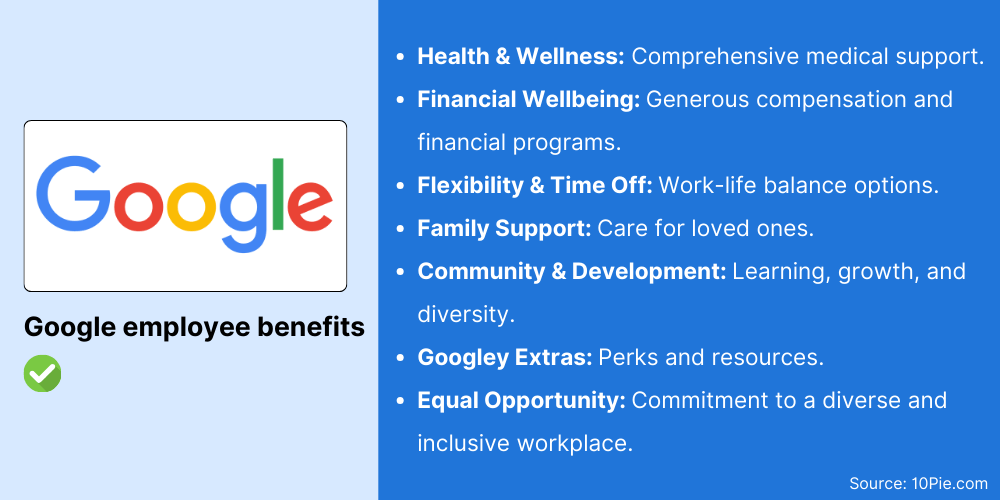
Google, as a company, has always had the reputation for being the dream tech company to work at. From its revolutionary office design to its long list of employee benefits, there is doubt why it often wins the title of having the best company culture.
Despite being a tech titan, the company leaves no room to spoil its employees and keep them happy. The company is often called the pioneer behind the idea of a flexible work culture where employees are given the opportunity to approach their work how they want to.
Their office space is full of amenities that keep the employees entertained and eager to come to the office the next day. But all fun apart, the company culture is so inclusive that hierarchy is not a barrier to knowledge transfer.
The company supports each of its valuable employees with physical and mental health care insurance, regular bonuses, retirement plans, student loan reimbursements, financial coaching, fertility and caregiver leaves, and the list goes on!
Not to mention, they believe in equal opportunity and talent and are not biased against qualified candidates even if they have criminal histories.
NOTE:
If you’re looking to improve the employee wellbeing culture at your organization, you can aso take inspiration from Google’s wellness programs and initiatives to its employees, including step challenges.
Here’s a detailed guide on how to run a step challenge and improve employee participation in this program.
4. Amazon’s employee benefits
If you shop online, you know what Amazon is, but apart from being the world’s largest e-commerce platform, it is also a multinational technology company that deals in cloud computing, online advertisement, AI, and digital streaming.
The company is counted among the world’s most valuable brands and is one of the Big Five American tech companies.
Amazon’s employee work culture:
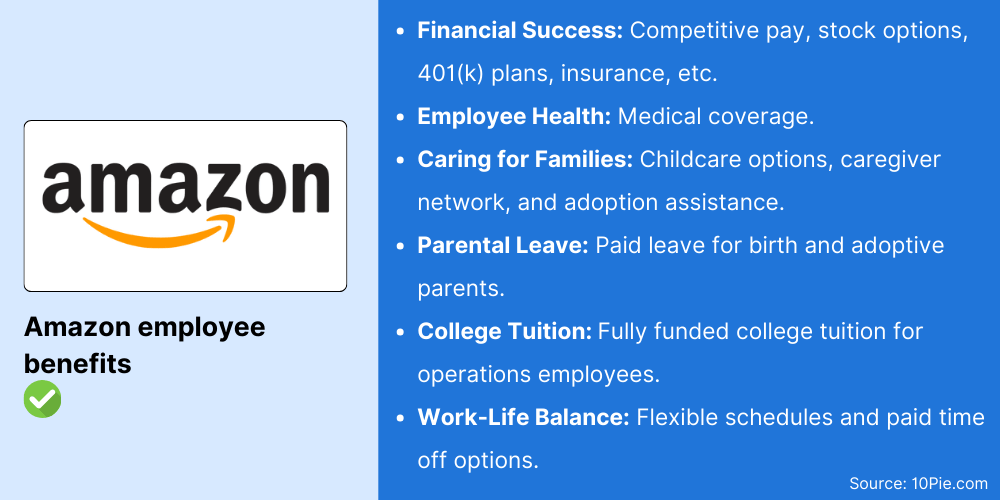
Apart from compensating the employees above the average wage, the best part about being an Amazonian (that’s what Amazon employees are called) is their employee benefit policies. The company aims to mark itself as “Earth’s best and safest employer,” and to achieve that; it tries to deliver everything and more that an employee could expect from a workplace.
Their company culture is welcoming, diverse, and inclusive, and they actively invest billions in upskilling their employees through leadership programs. Employees’ safety is something they greatly stress upon. And during COVID-19, they invested billions of dollars to keep their employees safe.
Like any great company, Amazon also focuses on work-life balance, which is why they have unique and flexible schedules for students, new parents, part-timers, or full-timers.
Learn about technology trends.
5. Semrush’s employee program
Semrush is a SaaS-based company that provides a comprehensive platform used for online visibility management and content marketing. They have over 50 tools and reports that help online marketers in aspects like SEO, PPC, SMM, Keyword Research, PR, Content Marketing, and so on.
Semrush’s employee work culture:
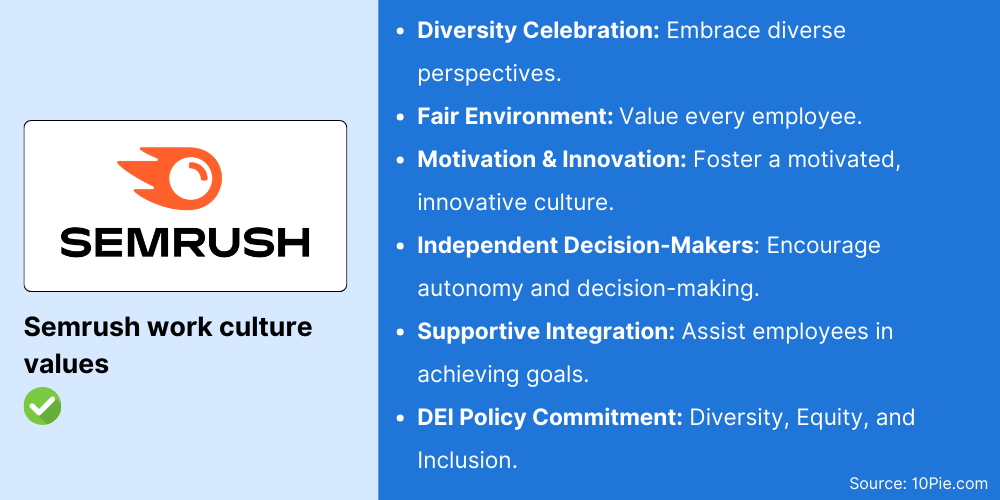
To create a supportive employee work culture, the company often takes initiatives, and one of the recent ones includes its Trust PTO policy. Semrush believes that, in order to avoid burnout and delivery excellency, the employees should take as much time as they need.
So, under this policy, they grant eligible employees days off above the limit of traditional paid time-offs. This work-life balance policy also doubles as an employee recognition policy, as the employees feel recognized and rewarded for their efficiency and hard work.
Not to forget, besides this, the company implements the idea of equal opportunity, diversity, and inclusivity in its 13 worldwide offices.
6. Airbnb employee program
Airbnb is an America-based company that operates the largest online marketplace for short and long-term homestays and experiences. It connects people who want to rent out their property with people who are looking for accommodations.
Airbnb’s employee work culture:
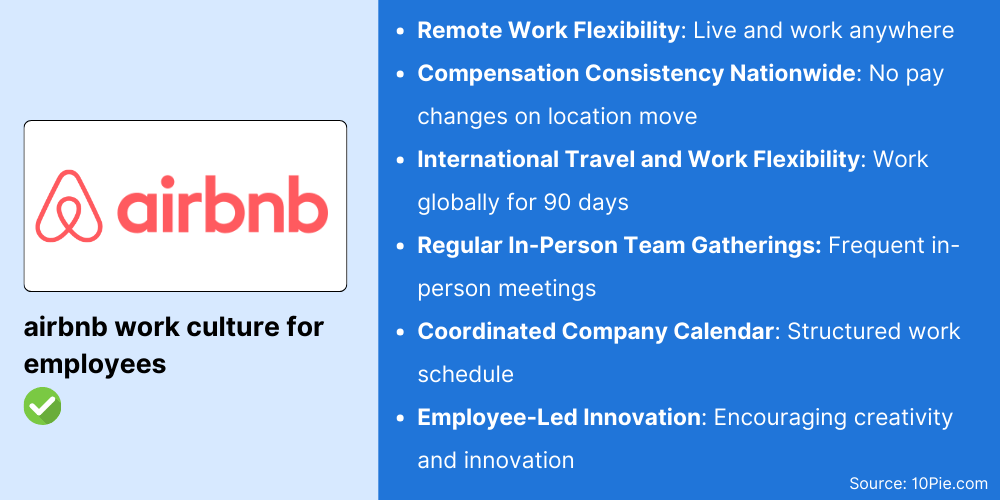
Much like their business model, Airbnb embraces a flexible work model, allowing employees to work from anywhere and encouraging collaboration through regular in-person gatherings. This approach matches broader workforce trends, as about 98% of professionals say they want to work remotely at least part-time for the rest of their careers.
The approach goes perfectly with the changing landscape of remote work, valuing talent globally and aiming for a more diverse workforce. Under their unique policies, employees can relocate within their country without a change in compensation and even work from different countries for up to 90 days a year.
It is one of the key moves behind their employee retention policies, as who wouldn’t want to save by relocating to a place that has low purchasing power parity (PPP) without worrying about company policies?
Besides, the company also emphasizes trust, maintaining structure, and nurturing creativity while valuing human connections, underlining a commitment to employee engagement and well-being.
7. Microsoft’s diversity and employee benefits
Microsoft is a multinational tech company that is best known to us for its software products. They are one of the pioneers of the current global tech industry, and besides the softwares, they also manufacture hardware and provide other services to make our lives easier.
Microsoft’s employee work culture:
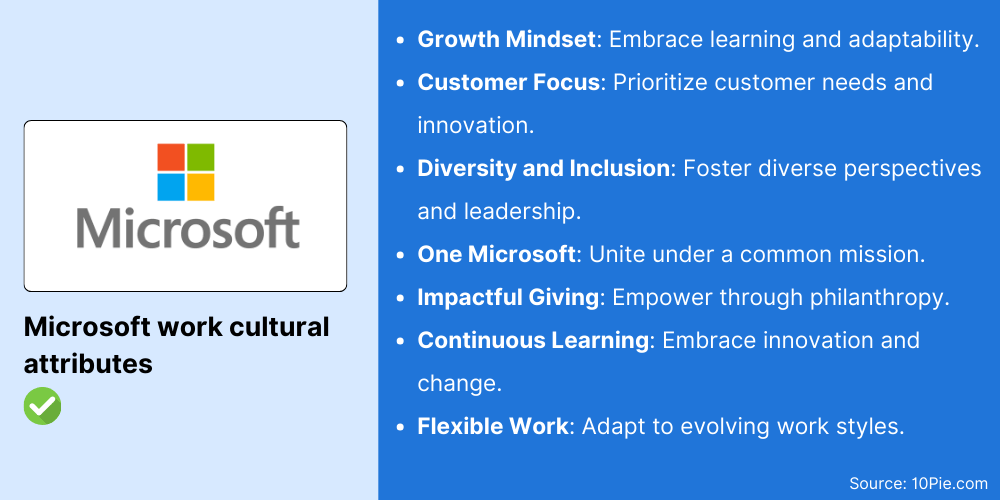
After the joining of the recent CEO, Mr. Satya Nadella, a lot of redefinition has happened in Microsoft’s employee work culture. While continuing with its growth mindset, the company now also focuses on things like empathy, collaboration, diversity, and inclusion and aligning the company’s goal with the individual’s growth.
The upgraded growth mindset lets the employees be more experimental and innovative. To keep the creative juice flowing, the employees are often prompted to do things that make them happy, even if it is completely unrelated to their job at Microsoft. Over time, employees can monetize their newly acquired skills and discover what is it that they truly love doing at Microsoft.
Apart from this unique approach, the company provides every employee benefit that you can expect from a tech giant, such as paid holiday trips, pension plans, investment support, refinancing student loans, and so on.
8. Adobe’s employee wellbeing culture
Adobe is a multinational computer software company that was a pioneer in the paper-to-digital transformation with the invention of document formats called PDFs. They also have very popular multimedia and creativity software products you may know, such as Photoshop, Adobe Illustrator, Lightroom, Premiere, etc.
Adobe’s employee work culture:
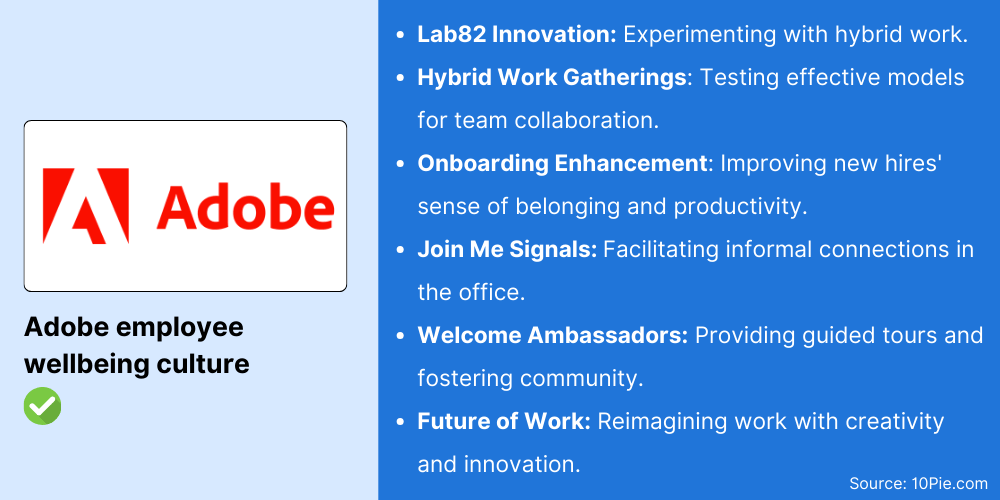
Adobe is quite popular for its people-centric approach to business and was also on the list of “ America’s Best Employers: 2021” by Forbes. How did they do that? By following some very primal ideas like employee recognition, employee development, diversity and inclusion, and implementing actionable policies for work-life balance to avoid burnout.
The company understood the basic needs of a happy employee and served them to their best. For example, since 2001, every year, the company has presented 12 employees with the Adobe Founder’s Award to honor their long-term dedication to the company.
They have a variety of family-friendly leave policies, did no layoffs during COVID-19, and provided regular company-wide day offs every Friday after discovering that employees were fatigued and were not taking the time off they needed.
9. Zoom’s employee wellbeing culture
Zoom is one of the leading video conferencing software apps that is more popular amongst professional setups and virtual social events. While many of us think it is a product of COVID-19, you will be shocked to know that over half of the Fortune 500 companies used Zoon in 2019.
Zoom’s employee work culture:
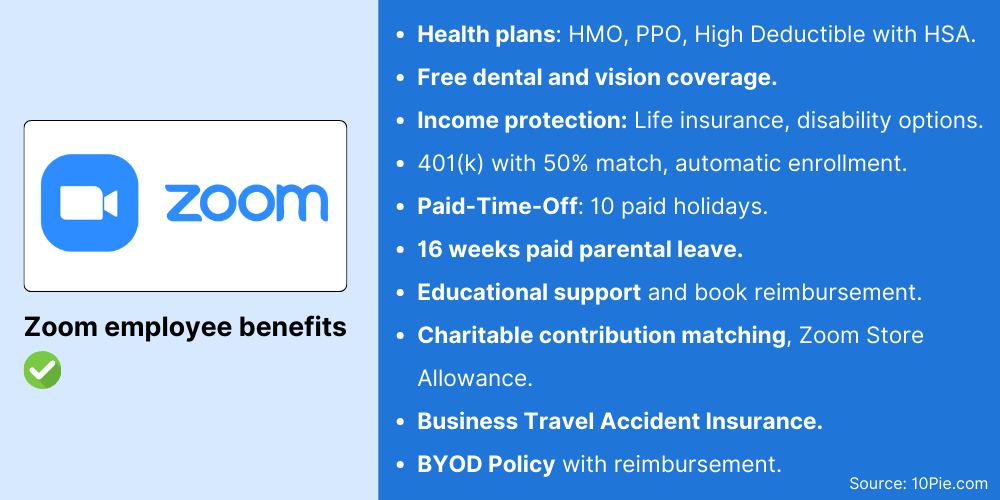
Zoom cultivates a culture around the value of care and believes in keeping both its customers and employees equally happy. The company has quite a few awards in its name for being the best employer. Both in 2020 and 2021, it was recognized for having the happiest employees.
To keep their employees happy, the company has adopted a system called “the Zoom Happiness Measure,” which tracks and recognizes when an employee may not be happy and proud of their work. Apart from this unique system, they also follow two easier ways, which are encouraging employees to participate in charity works they believe in and giving option of working from home based on their roles.
They believe in the fact that post-pandemic people have a different outlook towards life, and people now try to fit work around their life and not fit life around their work. So, in such conditions, giving employees the flexibility to work from home is the biggest perk.
10. Oracle’s diversity and inclusion
Oracle is a technology provider company with a complete suite of integrated cloud applications and cloud infrastructure platforms. One of their iconic software product is Java, which is a cult favorite of coders.
Oracle’s employee work culture:
Oracle believes diversity and inclusion are two of the most important pillars of its innovation and success. They say diverse perspectives make ideas better and teams stronger.
To support their diverse workforce, they have built an extensive employee resource group that actively helps connect diverse communities in the company and make them empowered.
In fact, they have different inclusion programs dedicated to specially enabled people, the military community, the LQBTQ+ community, and even those who wish to relaunch their careers. The company believes no talent should be wasted due to some social constructs. Apart from being highly inclusive, the company also supports its employee’s talent development programs and inspires them to deliver their best.
How to analyze employee and work culture before joining a tech company?
Whether you’re a student eager to kickstart your tech career or an experienced professional considering a switch, it’s crucial to evaluate a company’s employee and work culture before making a commitment.
Follow these actionable steps to distinguish between red flags and green flags when assessing a tech company’s culture.
| Steps to analyze employee and work culture | Description |
| 1. Research Company Values and Mission | – Review the company’s official mission statement. |
| – Assess alignment with your personal values and mission. | |
| 2. Scour Employee Reviews | – Positive alignment indicates a good cultural fit. |
| – Read employee reviews on platforms like Glassdoor, Indeed, or Blind. | |
| 3. Connect with Current or Former Employees | – Categorize compliments and complaints to identify culture, ethics, and work-life balance patterns. |
| – Find current or former employees on LinkedIn or other social media platforms. | |
| 4. Assess Diversity and Inclusion Efforts | – Engage in open conversations to gain insights on day-to-day work, team dynamics, and growth opportunities. |
| – Check if the company hosts diversity-related events, webinars, or conferences. | |
| – Look for evidence of diverse teams and leadership roles. | |
| 5. Review Employee Benefits and Perks | – Commitment to diversity indicates an inclusive culture that fosters innovation. |
| – Examine the employee benefits package, including healthcare, retirement plans, flexible hours, and wellness programs. | |
| 6. Gauge Work-Life Balance | – During interviews, inquire about work hours and overtime expectations. |
1. Research Company Values and Mission
Almost any and every well-established company will have its official website, which mentions its mission statement. Have a look at it and think clearly if their values and mission are something that aligns with your personal values and mission.
If it is a yes, then it is a good sign!
Find top companies to work for:
- Find the best data annotation companies in the world
- Top Cyber Security Companies In India
- Top Data Science Companies In Bangalore
- Top Artificial Intelligence Companies In Chennai
2. Scour Employee Reviews
Take the help of websites like Glassdoor, Indeed, or Blind for employee reviews and insights. Make a table of compliments and complaints, and try to draw a pattern to understand the company’s culture, ethics, and work-life balance.
3. Connect with Current or Former Employees
Search with the company’s name on LinkedIn, go to the people section, or use other social media platforms and reach out to current or former employees.
Engage in open and honest conversations about their experiences. Ask questions about their day-to-day work, team dynamics, and opportunities for growth.
4. Assess Diversity and Inclusion Efforts
Many tech companies host webinars, conferences, and networking events that you can join to see the company’s diversity and inclusion.
Look for evidence of diverse teams and leadership roles. A commitment to diversity usually indicates an open and inclusive work culture that fosters innovation and creativity.
5. Review Employee Benefits and Perks
Go through the employee benefits package, such as healthcare, retirement plans, and additional perks such as flexible working hours, remote work options, or wellness programs. You can also explore the benefits of HRMS to see how HR software helps improve employee satisfaction and engagement.
such as healthcare, retirement plans, and additional perks such as flexible working hours, remote work options, or wellness programs.
A company that invests in its employees’ well-being is likely to prioritize a positive work culture.
7. Gauge Work-Life Balance
While interviewing or interacting with company employees, ask questions about the company’s expectations regarding work hours and overtime.
A tech company that values work-life balance will provide clear policies and support to help employees maintain a healthy work-life balance.
Corporate gifting for tech employees
Corporate gifting is an important aspect of employee recognition and appreciation that can significantly contribute to a positive work culture. Many successful tech companies incorporate thoughtful gifting practices into their employee engagement strategies.
Here’s why corporate gifting matters:
- Shows appreciation: Gifts demonstrate that the company values its employees’ contributions.
- Boosts morale: Thoughtful gifts can uplift spirits and create a positive work environment.
- Strengthens relationships: Gifting can foster stronger connections between employees and management.
- Reinforces company culture: Gifts aligned with company values can reinforce the organizational culture.
- Improves retention: Employees who feel appreciated are more likely to stay with the company.
When implementing a corporate gifting program, consider the following best practices:
- Personalize gifts when possible
- Align gifts with company values and culture
- Offer choice or variety to cater to different preferences
- Time gifts strategically (e.g., work anniversaries, project completions)
- Include meaningful messages with gifts
By incorporating a well-planned corporate gifting strategy, tech companies can further enhance their work culture and employee satisfaction.
Conclusion
In short, these tech giants have shown that a positive work culture is a win-win for employees and companies alike.
When considering a tech job, research the company’s values, read reviews, and connect with current or former employees to find the right fit for your career goals. A good work culture isn’t just a perk; it’s a key ingredient for success in the tech world.
References:
- https://jobs.netflix.com/culture
- https://careers.linkedin.com/culture-and-values
- https://careers.google.com/programs/people-with-disabilities/
- https://www.aboutamazon.com/workplace/employee-benefits
- https://careers.semrush.com/en/sustainability/
- https://www.semrush.com/news/242259-semrush-kicks-off-2023-with-global-trust-pto-policy/
- https://news.airbnb.com/airbnbs-design-to-live-and-work-anywhere/
- https://careers.microsoft.com/v2/global/en/home.html
- https://careers.zoom.us/benefits

Mrittika Sengupta is a professional content writer with more than 2 years of experience in writing for some of the popular blogs on marketing and tech fields. She also mentors aspiring writers transitioning from academia to the commercial writing world.

